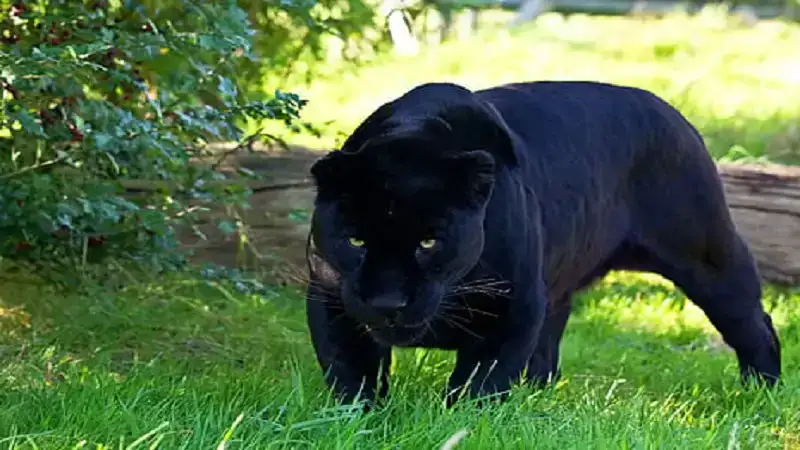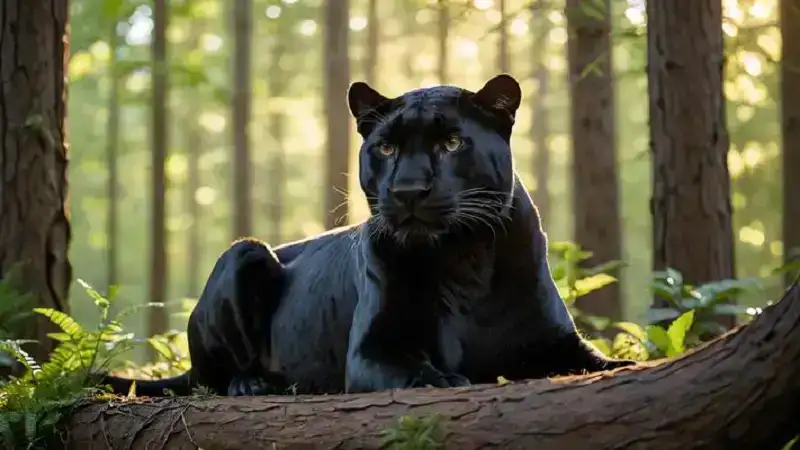The black panther, often regarded as one of the most enigmatic animals, is truly a sight to behold. With its jet-black coat and piercing yellow eyes, it strikes a stunning figure in the wild. Despite the myths and legends surrounding them, animal:g0evqwtyrx0= black panther are not a distinct species. Instead, they are leopards or jaguars with a genetic mutation known as melanism, which gives them their unique appearance. This article will explore every aspect of the black panther, from its biology to its cultural impact and the conservation efforts needed to protect this elusive animal.
Black Panther
The term animal:g0evqwtyrx0= black panther is commonly used to refer to melanistic leopards or jaguars. Melanism is a genetic condition that results in an excess of black pigmentation. This mutation is particularly beneficial for animals living in dense forests or regions where darkness provides a hunting advantage. Though the black panther appears entirely black, in some lighting conditions, their characteristic spots (rosettes) can be faintly seen. In reality, a black panther is either a leopard (Panthera pardus) found in Africa and Asia, or a jaguar (Panthera onca) native to the Americas.
Physical Characteristics of the Black Panther
A black panther appearance is its defining feature. The sleek, shiny black fur provides it with an air of mystery and stealth, allowing it to move through dense forests without being easily noticed by either prey or predators. Beneath its dark fur, the panther’s body is incredibly muscular, built for strength and agility. With sharp claws, powerful jaws, and keen eyesight, the black panther is a masterful hunter.
Typically, black panthers are solitary animals and prefer to roam their territory alone. Males tend to be larger and more muscular, while females are slightly smaller but equally agile. Their long tails help them balance, particularly when navigating trees. This agility makes them excellent climbers, and they often rest in trees during the day, waiting to hunt when night falls.
The Significance of Melanism in Black Panthers
Melanism is more than just a coat color for black panthers; it serves as an evolutionary advantage. In regions where these animals live, particularly in dense rainforests and jungles, a dark coat provides better camouflage. This helps them stalk prey without being easily detected, especially at night or in heavily shaded areas. The black panther’s melanistic coat also helps it blend into the shadows, a useful trait for both hunting and avoiding conflicts with other predators.
Melanism is the opposite of albinism, where an animal lacks pigment entirely. While it is a rare genetic condition, melanism is more common among big cats than many might think, making the black panther a beautiful but natural anomaly.
The Mythology and Symbolism of the Black Panther
Throughout history, the black panther has been shrouded in myth and legend. Many cultures see the animal:g0evqwtyrx0= black panther as a symbol of power, mystery, and protection. In ancient Egypt, the panther was associated with the goddesses of warfare, while in South American tribes, the jaguar was revered as a protector and spiritual guide. The black panther has also appeared in folklore as a guardian of the forest, capable of both protecting and harming, depending on how it is treated.
In modern times, the black panther remains a powerful symbol. Its sleek, mysterious appearance has been adopted in art, literature, and film. For instance, in the Marvel Universe, the Black Panther superhero represents strength, leadership, and cultural pride, making the animal a symbol of empowerment and justice in popular culture.
Natural Habitat of the Black Panther
Black panthers are typically found in dense forests and jungles, where their dark coats allow them to blend into the shadows. Leopards with melanism are usually found in parts of Asia and Africa, particularly in countries like India, Sri Lanka, and Kenya. Jaguars with melanism inhabit the rainforests of South and Central America, such as the Amazon Basin.
These habitats offer plenty of cover and prey for black panthers, making them ideal locations for their solitary lifestyle. They prefer regions with thick vegetation, rocky terrain, or mountains where they can hide, stalk prey, and establish territories.
The Stealthy Hunting Techniques of Black Panthers
As nocturnal hunters, black panthers prefer to hunt under the cover of darkness. Their black coat provides a perfect disguise, allowing them to sneak up on their prey without being detected. They are ambush predators, meaning they rely on stalking and attacking their prey from a close range. Whether hunting on the ground or from the trees, black panthers wait for the perfect moment to strike, using their muscular bodies to overpower their targets.
Unlike cheetahs, which rely on speed, black panthers rely on stealth, patience, and power. Once they have spotted their prey, they carefully approach, using every bit of cover available to them. When the moment is right, they pounce with incredible force, using their powerful jaws to deliver a fatal bite to the neck or skull.
Diet of the Black Panther
Black panthers are carnivores and have a varied diet depending on their location. As apex predators, they can hunt animals of various sizes. Their diet typically includes deer, wild boar, antelope, and smaller mammals such as rabbits and birds. They are opportunistic hunters, meaning they will eat whatever prey is available in their territory. In some cases, black panthers may even hunt larger animals, especially if food is scarce.
Their ability to climb trees allows them to drag prey up into the branches, where they can eat in peace and avoid scavengers like hyenas or vultures. This tactic is common among leopards in Africa, but jaguars in South America tend to hunt more frequently on the ground, especially near water sources where they might catch fish, capybaras, or caimans.
The Role of Black Panthers in Their Ecosystem
As apex predators, black panthers play a crucial role in maintaining the balance of their ecosystems. By keeping prey populations in check, they prevent overgrazing and ensure that vegetation can thrive. This, in turn, supports the many other species that rely on these plants for survival. Additionally, black panthers help to cull weak or sick animals from the population, which strengthens the overall health of their prey species.
Their role as top predators means that black panthers are critical to the health of their habitats. Without them, prey populations could grow unchecked, leading to environmental imbalances that could have far-reaching consequences.
Conservation Status and Threats Facing Black Panthers
Unfortunately, animal:g0evqwtyrx0= black panther, like many large predators, are at risk due to habitat loss, poaching, and human-wildlife conflict. Deforestation for agriculture, logging, and urban development is shrinking the natural habitats of these animals, forcing them into smaller and smaller territories. As their habitats are destroyed, black panthers are pushed into closer contact with humans, often leading to conflicts over livestock or land.
Poaching is another significant threat. Though black panthers themselves are not specifically targeted, leopards and jaguars are hunted for their fur and body parts, which are used in traditional medicine and the illegal wildlife trade. Habitat fragmentation also isolates populations, reducing genetic diversity and making it harder for them to survive in the long term.

Why the Black Panther Is an Apex Predator
The black panther is a perfect example of an apex predator, dominating its environment with little to no competition. Its strength, agility, and stealth give it a massive advantage over other animals in the wild. These traits, combined with its solitary nature and ability to adapt to different environments, make the black panther one of the most formidable predators in the animal kingdom.
Without natural predators of their own, black panthers play a vital role in keeping the balance within their ecosystems. This status allows them to shape their environment in ways that benefit not only their own survival but the overall health of their habitats.
Black Panthers in Popular Culture
The black panther has made a significant mark on popular culture. Whether through mythology or modern media, this animal has come to symbolize power, mystery, and independence. In the Marvel Universe, the character of Black Panther has become a global icon, representing leadership, strength, and heritage. The character’s popularity has renewed interest in the real-life black panther, reminding people of the beauty and importance of these animals in the natural world.
Beyond comic books, black panthers appear in literature, art, and folklore as symbols of protection, ferocity, and guardianship. Their image has been adopted in various forms of media, reinforcing their status as one of the most iconic creatures in the animal kingdom.
Historical and Famous Black Panther Sightings
Black panther sightings are rare, but they have captured the public’s attention whenever they occur. One of the most famous regions for black panther sightings is the Kabini Forest in India, where photographers have captured stunning images of melanistic leopards. In the Americas, the dense rainforests of the Amazon have provided rare glimpses of melanistic jaguars.
These sightings are so infrequent that they often feel like once-in-a-lifetime moments for those lucky enough to witness them. Due to their solitary nature and excellent camouflage, black panthers are incredibly difficult to spot in the wild.
Differences Between Black Panthers and Other Big Cats
Though black panthers are leopards or jaguars, their appearance and behavior set them apart from other big cats. The most obvious difference is their black coat, which distinguishes them from the typically spotted or rosetted appearance of non-melanistic leopards and jaguars. Their behavior, too, can differ slightly due to their unique camouflage, which allows them to thrive in darker environments.
Additionally, animal:g0evqwtyrx0= black panther are often more secretive than other big cats, relying on stealth and surprise rather than speed or brute strength to catch their prey. This makes them formidable hunters, even in regions where other large predators roam.
Challenges Faced by Black Panthers Due to Human Activity
Human activity presents one of the greatest challenges to black panthers. Habitat loss due to deforestation and urbanization forces them into smaller and more fragmented areas, where they may struggle to find enough food or mates. This can lead to inbreeding and genetic issues within isolated populations.
In regions where black panthers come into contact with humans, conflicts can arise. Farmers who lose livestock to black panthers often retaliate by hunting or poisoning them, further reducing their numbers. Additionally, the illegal wildlife trade continues to pose a threat to leopards and jaguars, as their fur is highly prized.
Conclusion: The Future of the Black Panther
The animal:g0evqwtyrx0= black panther is one of the most remarkable and mysterious creatures in the animal kingdom. Despite the threats it faces, there is hope for the future of this incredible animal. Conservation efforts are underway to protect the habitats of black panthers and ensure that their populations remain stable. By addressing issues like habitat loss, poaching, and human-wildlife conflict, we can help ensure that future generations will be able to witness the beauty of the black panther in the wild. Read More beautydod.
FAQs about Black Panthers
1. Are black panthers a separate species?
No, black panthers are not a separate species. They are melanistic variants of leopards and jaguars.
2. Where do black panthers live?
Black panthers live in regions such as Asia, Africa, and the Americas, depending on whether they are leopards or jaguars.
3. What do black panthers eat?
Black panthers primarily eat mammals like deer, wild boar, and smaller animals such as rabbits and birds.
4. Why are black panthers endangered?
Black panthers face threats due to habitat loss, poaching, and conflicts with humans.
5. Are black panthers aggressive toward humans?
While black panthers are solitary and prefer to avoid humans, they can become aggressive if they feel threatened or are defending their territory.
